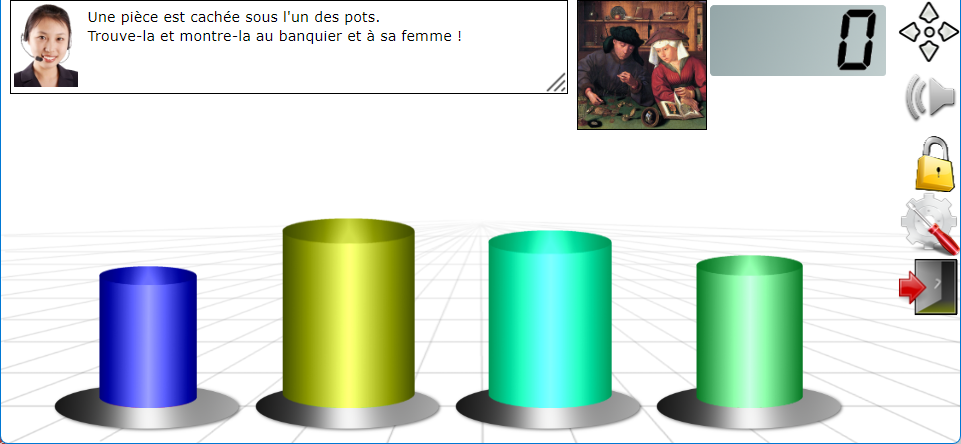The Hanoi Mystery puzzle game is largely inspired by the famous Tower of Hanoi puzzle. The logic behind the puzzle is the same, but it’s more playful.
Principle of the game
The game is played by two players. Each game has two rounds. One player is the “coder” and sets up the puzzle; the other player, the “decoder,” attempts to solve it. The roles are reversed in the next round.
Unbeknownst to the decoder, the coder places a coin on a board with 3 or 4 slots. He then places a number of interlocking hollow pots (in the form of hollow cylinders on the site) on the board, so as to hide the coin. Then he calls the decoder. The decoder has to move the pots one by one, with one hand only, and place them on empty spots or on smaller pots, until he uncovers the coin completely and can grasp it with his hand – which presupposes that he has placed all the pots on the other spots. The number of moves is counted; the player with the fewest moves wins the game. To avoid brutalizing these pots, a touched pot counts as a move even if it is not moved.
For each game, the number of usable locations – 3 or 4 – as well as the number of pots, from 4 to 10, are decided by the two players, by mutual agreement.

Interest
In the original puzzle, all the information is visible and therefore known by the decoder. Here, part of the information is invisible at the start, since the coin is hidden under one or more pots, and only the largest pots are visible. The role of the coder is therefore to try to hide the coin as best as possible; as for the decoder, he must sharpen his strategy and mobilize his working memory, to discover the coin as quickly as possible. The game is much more interesting – because easier – with 4 locations. The most enjoyable games have 10 pots. In general, with 4 locations, we can always find the solution in 40 moves at the most.
By varying the number of spaces and the number of pots, the game can be adapted to suit all ages. This game can be played without a computer, using interlocking cubes, available in toy stores; it is always a hit with young and old alike.
Role of the coder
The coder should try to create the most difficult combinations to crack. Experience shows that it’s better to hide the coin under the smallest pot, because it increases the number of moves required to uncover it. But, of course, since the decoder expects the coin to be hidden under the smallest pot, it’s possible to occasionally set a trap and place it under a slightly larger pot…
The second trick is to put a few more pots on the location containing the part, to make accessing it a little more difficult.
On the site the computer will act like this if you let it code.
Role of the decoder
He’s the one with the biggest job!
Not only does he have to find out where the piece is, but he has to come up with a strategy to reveal it, and to do this, he has to memorize the position of the different pots because, let’s not forget, they are hidden by the biggest ones. To help him, in addition to memorizing the size, he can use the colors; these are chosen randomly at the start of the game, but then they don’t change. Be careful though, because if you choose fewer than 10 pots, they will be drawn randomly from the ten possible: so the sizes and colors can change from one game to another, for the same number of pots.
Not only does he have to find out where the piece is, he has to devise a strategy to reveal it, and to do this he has to memorize the position of the different pots, because, let’s not forget, they’re hidden by the bigger ones. To help him, in addition to memorizing the size, he can use the colors; these are chosen randomly at the start of the game, but then they don’t change. Be careful, though, because if fewer than 10 pots are chosen, they will be drawn randomly from among the ten possible: so sizes and colors may change from one game to the next, for the same number of pots.
The strategy of displacement
This is the principle behind the Hanoi Towers puzzle. It involves recursive reasoning, mobilizing both working and procedural memory. We can, however, simplify procedures a little by adopting a fairly simple rule, when we need to move a group of pots from one location to another.
Generally, when we have to move n pots, we always ask ourselves: “where should I place the first pot in the series?”
The answer is quite simple. Consider a three-position board, as in the tower puzzle.
Of these three positions, we distinguish:
- the starting position, on which my pile to move is located
- the destination position, to which I want to move the pile of starting pots. This location, of course, is available for this; it is empty or it contains pots even smaller than those to be moved.
- the intermediate position, which will be used in movements, and which is also available for this.
If you only have one pot to move, simply place it in the destination position. You only have one move.
If you have two pots, you need to put the first one in the intermediate position, move the second one from the starting position to the ending position, and then move the one from the intermediate position to the finishing position. There are three moves to make. So, we start with the middle position.

For 3 pots, there are 7 moves, and you must start from the finish position. Here is the video that shows the moves:
Continuing the reasoning, we see that for an odd number of pots, the first one must be moved to the final position. When there is an even number of pots, we must start from the intermediate position.
Odd: arrival
Even: intermediate
By applying this trick, you can significantly reduce the number of guesses! But, of course, this assumes that you know how many pots there are, which requires considerable memorization work.
When there are 4 positions we can reduce the number of moves.
The challenge: computer versus player
In the challenge, the player plays against the computer. The player always chooses the number of pots and the size of the game board, thus setting the level of difficulty.
A game is played in two asymmetrical rounds; to balance the odds, an even number of rounds must be played.
At the very start, lots are drawn to decide who goes first. Then, whoever finishes the second round starts the first round of the next game.
The computer begins by creating a secret combination to be discovered. This is its “encoder” function, described above. The first player (human or machine) must find the coin in as few moves as possible. Then, the same combination is proposed to the second player (machine or human), who must also find the coin, trying to do better than the first player.
It’s easy to see why the game is asymmetrical. The second player has the advantage of already knowing the position of the piece (if the first player has finished) and may even have memorized the position of the pots. While the first player has to grope to find the piece, the second can immediately apply the best strategy to discover it. This gives him a clear advantage.
To restore the balance, you must therefore play at least 2 games.
I want to point out that the computer is not cheating. At the beginning of the game, the solving algorithm “sees” exactly what the human player sees, and it “knows” exactly what the player knows: how many slots there are, how many pots there are, which pots are visible. No more, no less. Watching it do this, you might get the impression that it systematically jumps on the coin, wherever it is, as if it knows where it is, but that’s because the algorithm is optimized, not because it’s cheating! Look closely, you can see this better when there are 4 locations and a lot of pots. The algorithm also fumbles; it presents the path of the first solution it found, and it’s not necessarily the best.
So, if the computer starts, it is in the same situation as the player. The latter, if he observes well and memorizes correctly, can therefore win in the second round.
On the other hand, if it plays in the second round, the machine doesn’t let anything pass because it has all the information that the player left; and of course, it doesn’t forget anything.
In other words, yes, the machine is formidable in this game. But it does have one weak point: the algorithm is limited! In some cases, to keep the calculation time reasonable, I had to group the moves into heaps. Basically, this means that the algorithm will assimilate the movement of 2 pots to a single move, which will be broken down into 3 elementary movements at runtime. Sometimes, when working on a 4-position board, the program won’t realize that it can interrupt the elementary moves because the pot under which the coin is located is uncovered and can easily be moved to another position. So he plays an extra move. You can take advantage of that.

 Start the activity.
Start the activity.